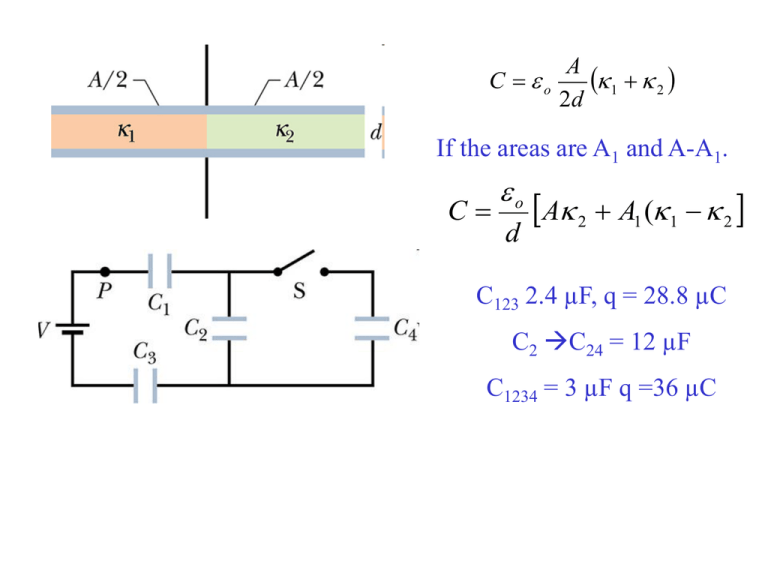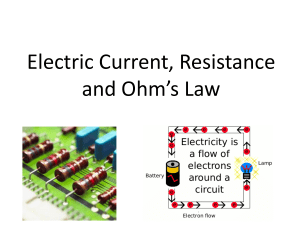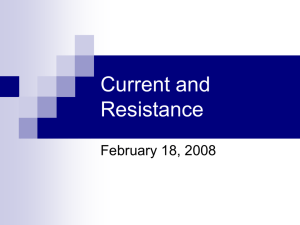advertisement

C o A 1 2 2d If the areas are A1 and A-A1. C o d A 2 A1 (1 2 C123 2.4 µF, q = 28.8 µC C2 C24 = 12 µF C1234 = 3 µF q =36 µC The force on a filling dielectric as it is inserted between the parallel plates of a capacitor. C C1 C2 1 dC C dx L o d x A1 1 L With the battery connected, U1 = ½CV2 F x 1 dU1 U1 dx L L With the battery disconnected, U2 = Q2/2C 1 dU 2 F dx U2 L With the battery connected, since x is increasing downwards, a negative force is upwards, pushing the dielectric away. With the battery disconnected, the force is positive and pointed downwards, pulling in the dielectric. The force is proportional to (κ-1) and inversely to L. Chapter 26 Current and Resistance In this chapter we will introduce the following new concepts: -Electric current ( symbol i ) -Electric current density vector (symbol J ) -Drift speed (symbol vd ) -Resistance (symbol R ) and resistivity (symbol ρ ) of a conductor -Ohmic and non-Ohmic conductors We will also cover the following topics: -Ohm’s law -Power in electric circuits (26 - 1) HITT The plate areas and plate separations of five parallel plate capacitors are capacitor 1: area A0, separation d0 capacitor 2: area 2A0, separation 2d0 capacitor 3: area 2A0, separation d0/2 capacitor 4: area A0/2, separation 2d0 capacitor 5: area A0, separation d0/2 Rank these according to their capacitances, least to greatest. a. 1,2,3,4,5 b. 5,4,3,2,1 c. (524) ,(13) d. 4, (12), 5,3 e. None of these A B Electric current Consider the conductor shown in fig.a. All the points inside the conductor and on its surface are at the same potential. The free electrons inside the conductor move at random directions and thus there is not net charge transport. We now make a break in the conductor and insert a battery as shown in fig.b. Points A and B are now at potentials VA and VB , respectively. ( VA VB V the voltage of the battery) (26 - 2) The situation is not static any more but charges move inside the conductor so that there is a net charge flow in a particular direction. This net flow of electric charge we define as "electric currrent" (26 - 3) dq i dt Consider the conductor shown in the figure It is connected to a battery (not shown) and thus charges move through the conductor Consider one of the cross sections through the conductor ( aa or bb or cc ) dq The electric current i is defined as: i dt Current = rate at which charge flows Current SI Unit: C/s known as the "Ampere" conductor v +q i conductor v -q i Current direction : An electric current is represented by an arrow which has the same direction as the charge velocity. The sense of the current arrow is defined as follows: 1. If the current is due to the motion of positive charges the current arrow is parallel to the charge velocity v 2. If the current is due to the motion of negative charges the current arrow is antiparallel to the charge velocity v conductor v A +q i J conductor v A -q i i J A J Current density Current density is a vector that is defined as follows: i Its magnitude J SI unit for J : A/m 2 A The direction of J is the same as that of the current The current through a conductor of cross sectional area A is given by the equation: i JA if the current density is constant. If J is not constant then: i J dA We note that even though the current density is a vector the electric current is not. This is illustrated in the figure to the left. An incoming current io branches at point a into two currents, i1 , and i2 . Current io i1 i2 This equation expresses the conservation of charge at point a. Please note that we have not used vector addition (26 - 4) Drift speed When a current flows through a conductor the electric field causes the charges to move with a constant drift speed vd . This drift speed is superimposed on the random motion of the charges. J nvd e J nevd Consider the conductor of cross sectional area A shown in the figure. We assume that the current in the conductor consists of positive charges. The total charge q within a length L is given by: q nAL e. This charge moves through area A in a time t L q nALe . The current i nAvd e vd t L / vd The current density J i nAvd e nvd e A A In vector form: J nevd (26 - 5) i - + V R R V i Resistance If we apply a voltage V across a conductor (see figure) a current i will flow through the conductor. V We define the conductor resistance as the ratio R i V SI Unit for R : the Ohm (symbol ) A A conductor across which we apply a voltage V = 1 Volt and results in a current i = 1 Ampere is defined as having resistance of 1 Q : Why not use the symbol "O" instead of " " A : Suppose we had a 1000 resistor. We would then write: 1000 O which can easily be mistaken read as 10000 . A conductor whose function is to provide a specified resistance is known as a "resistor" The symbol is given to the left. (26 - 6) i Resistivity E - + V J E E J Unlike the electrostatic case, the electric field in the conductor of the figure is not zero. We define as resistivity of the conductor the ratio In vector form: E J SI unit for ρ : E E J V/m V m m 2 A/m A The conductivity is defined as: 1 Using the previous equation takes the form: J E R L A Consider the conductor shown in the figure above. The electric field inside the V i conductor E . The current density J We substitute E and J into L A E V /L V A A L equation and get: R R J i/ A i L L A (26 -7) o o T To Variation of resistivity with temperature In the figure we plot the resistivity of copper as function of temperature T . The dependence of on T is almost linear. Similar dependence is observed in many conductors. The following empirical equation is used for many practical applications: o o T To The constant is known as the "temperature coefficient of resistivity". The constant To is a reference temperature usually taken to be room temperature (To 293 K ) and o is the resistivity at To . For copper o 1.69 108 m Note : temperature enters the equation above as a difference T To . Thus either the Celsius or the Kelvin temperature scale can be used. (26 -8) (26 - 9) Ohm's Law : A resistor was defined as a conductor whose resistance does not change with the voltage V applied across it. In fig.b we plot the current i through a resistor as function of V . The plot (known as "i - V curve" ) is a straight line that passes through the origin. Such a conductor is said to be "Ohmic" and it obeys Ohm's law that states: The current i through a conductor is proportional to the voltage V applied across it. Not all conductors abey Ohm's law (these are known as "non - Ohmic" ) An example is given in fig.c where we plot i versus V for a semiconductor diode. The ratio V / i (and thus the resistance R ) is not constant. As a matter of fact the diode does not conduct for negative voltage values. Note : Ohm's "law" is in reality a definition of Ohmic conductors (defined as the conductors that obey Ohm's law) A Microspopic view of Ohm's law : In order to understand why some materials such as metals obey Ohm's law we must look into the details of the conduction process at the atomic level. vd F A schematic of an Ohmic conductor such as copper is shown in the figure. We assume that there are free electrons that move around in random directions with an effective speed veff = 1.6 106 m/s. The free electrons suffer collisions with the stationary copper atoms. A schematic of a free electron path is shown in the figure in the figure using the dashed gray line. The electron starts at point A and ends at point B. We now assume that an electric field E is applied. The new electron path is indicated by the dashed green line Under the action of the electric force the electron acquires a small drift speed vd . The electron drifts to the right and ends at point B. (26 - 10) Consider the motion of one of the free electrons. We assume that the average time between collisions with the copper atoms is equal to . The electic field exerts a force F eE on the electron, resulting in an F eE acceleration a . The drift speed is given vd m m eE F by the equation: vd a (eqs.1) m J We can also get vd from the equation: J nevd vd (eqs.2) ne J eE m If we compare equations 1 and 2 we get: vd E 2 J ne m ne If we compare the last equation with: E J we conclude that: m 2 This is a statement of Ohm's law (the resistance of the ne conductor does not depend on voltage and thus E ) This is because m, n, and e are constants. The time can also be considered be independent of E since the drift spees vd is so much smaller than veff . (26 - 11) P iV Power in electric circuits : Consider circuit shown in the figure. A battery of voltage V is connected across the terminals a and b of a device. This can be a resistor, a motor, etc. The battery maintains a potential difference V between the terminals a and b and thus a current i flows in the circuit as shown in the figure. During the time interval dt a charge dq idt moves between the terminals. We note that Va >Vb . The potential energy of the charge decreases by an amount dU Vdq Vidt Using energy conservation we conclude that the lost energy has been transfered by the battery to the device nad has been converted into some other form of energy. The rate at which energy is transfered to the device is known as "power" and it is dU Vidt equal to: P Vi dt dt SI unit for P : V A It is known as the "Watt" (symbol W). (26 - 12) Pi R 2 V V2 P R If the device connected to the battery is a resistor R then the energy transfered by the battery is converted as heat that appears on R. If we combine the equation P iV V with Ohm's law: i , we get the following two equivalent expressions for R the rate at which heat is dissipated on R. Pi R 2 and V2 P R (26 - 13) hitt To store a total of 0.040 J of energy in the two identical capacitors shown, each should have a capacitance of: •A. 0.10 μF •B. 0.50 μF, 0.10 μF •C. 1.0 μF •D. 1.5 μF •E. 2.0 μF







